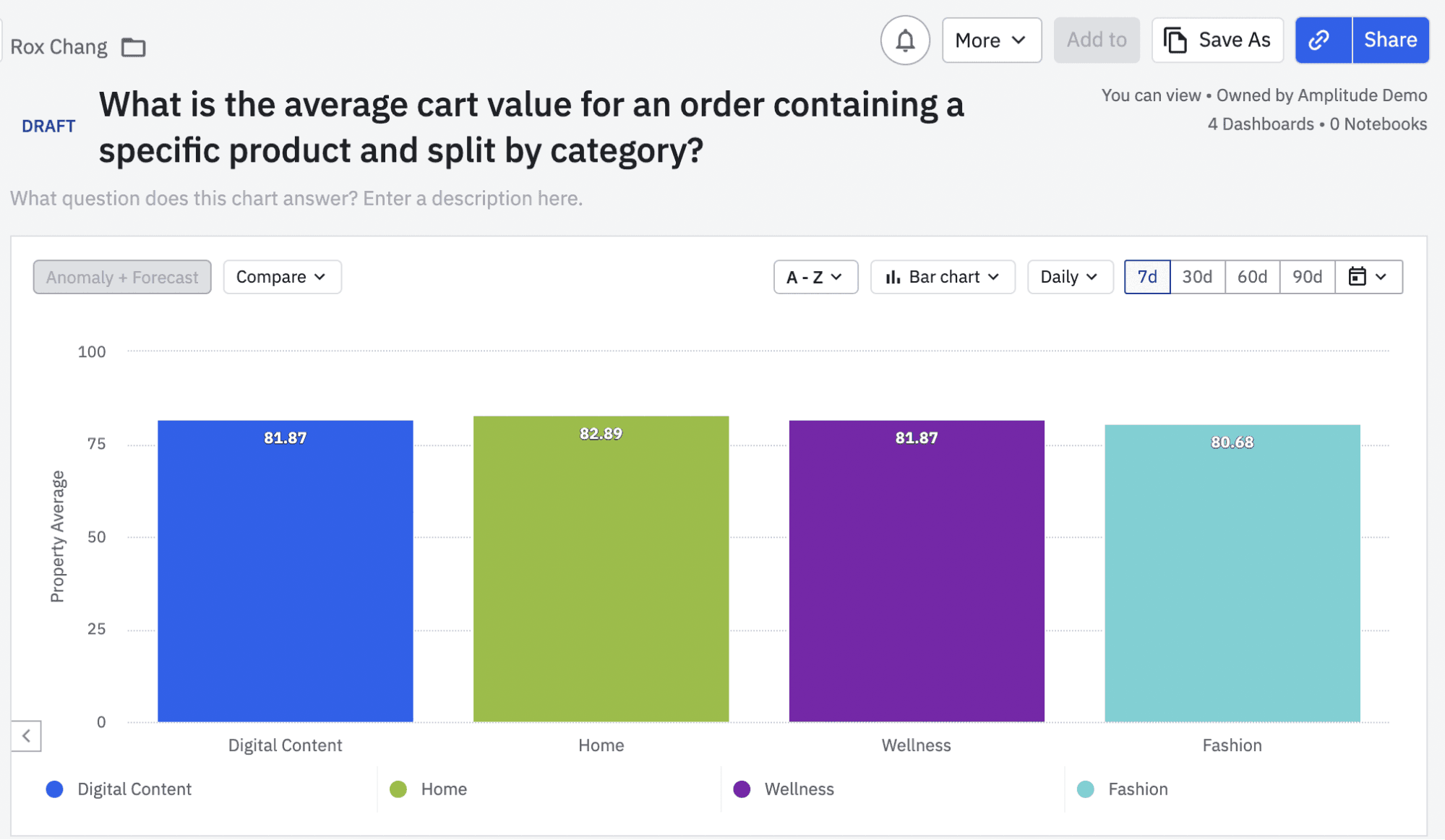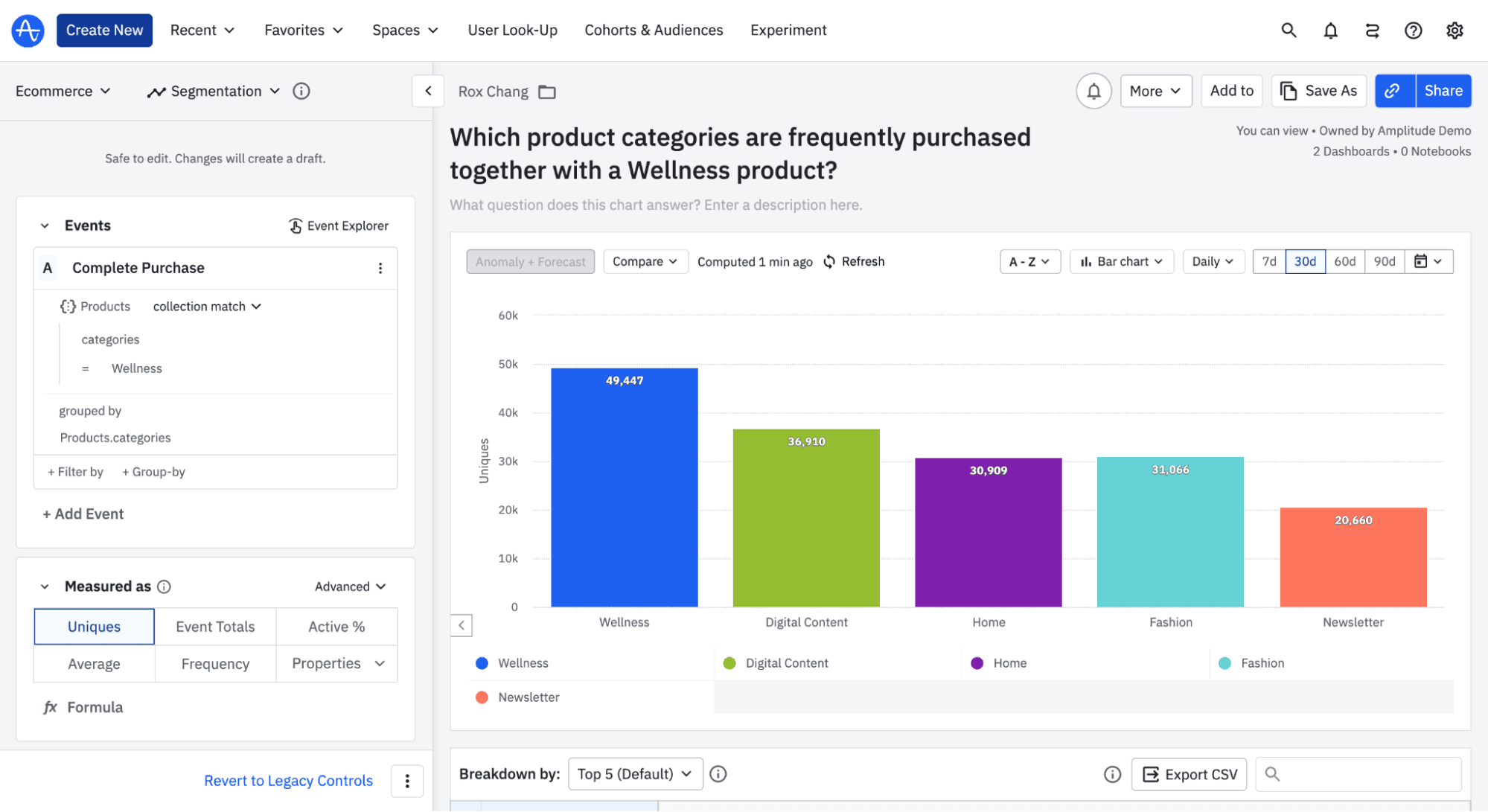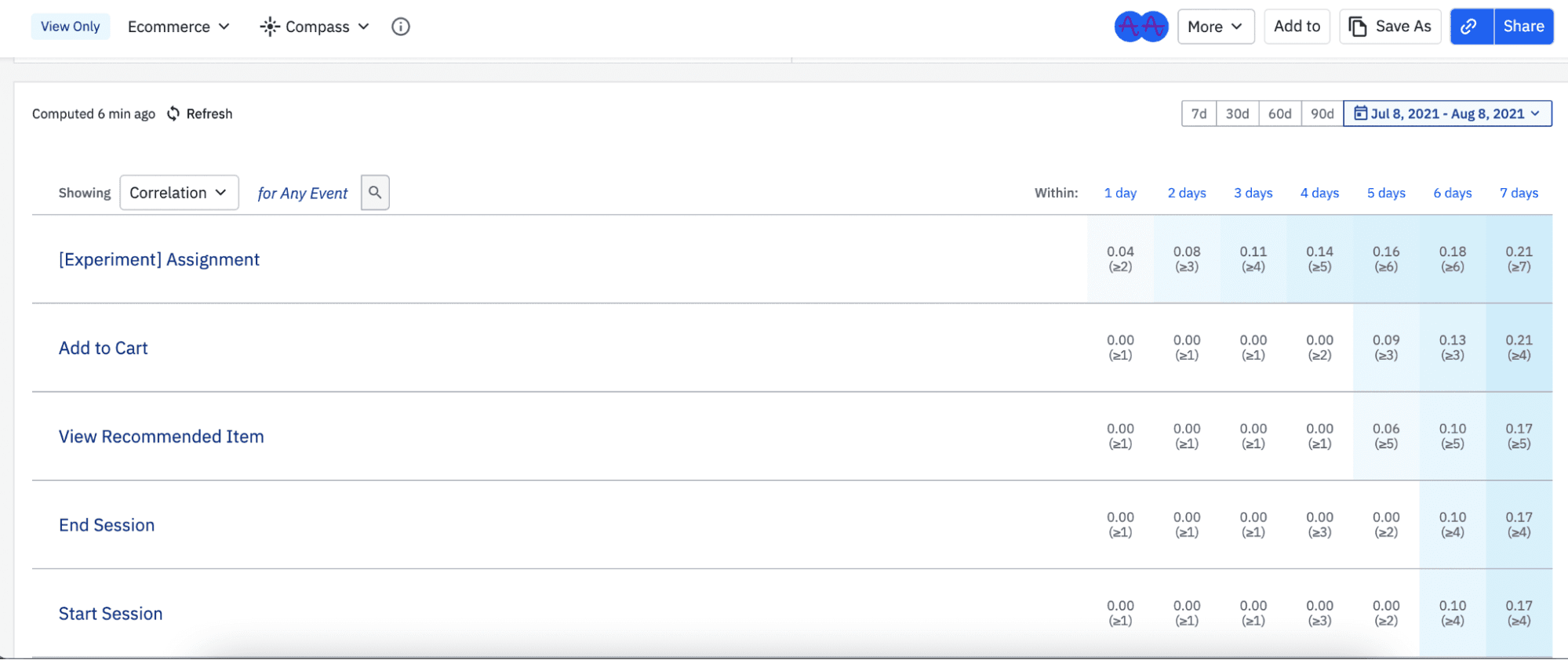What Is Average Order Value (AOV)? Definition and How to Calculate
Learn more about a key ecommerce metric: average order value (AOV) and why it's important to track. See how to improve AOV with analytics platforms like Amplitude.
Ecommerce has already revolutionized the ways consumers around the globe shop. And it’s still growing—global ecommerce sales are expected to swell more than 50 percent for the period from 2022 to 2026, reaching 8.1 trillion dollars, according to Statista.
If you own or operate an ecommerce brand, average order value (AOV) is one of the core revenue-related metrics you’ll want to keep an eye on. Let’s break down AOV and go over the ways you can impact this metric with customer purchase and behavioral analytics.
Key takeaways
- Average order value (AOV) is an ecommerce metric representing the typical dollar value of a given customer’s total order for a time period.
- Numerous factors, including product category, platform, and even time of day, can impact your ecommerce store’s AOV.
- You need to leverage your customer’s purchase and behavioral data to increase AOV for your store. You’ll generate higher customer satisfaction via personalization and valuable product recommendations.
What is AOV?
AOV (average order value) is a business metric measuring the average dollar amount of an ecommerce purchase on an ecommerce website or app.
AOV gives retail and ecommerce stores an idea of the total amount of money customers spend on the average order. Businesses can use the metric to draw general conclusions about larger customer purchasing patterns and behaviors.
How to calculate AOV
To calculate average order value, you divide the total revenue of your business over a given period by the number of orders during the same time.
AOV = Revenue / Number of orders
For example, let’s say you wanted to calculate AOV for your ecommerce store for Q3.
In Q3, the store earned $100,000 in revenue from 2,000 orders. So, your average order value formula would look like this:
AOV = $100,000 / 2,000
And your AOV for the period would equal $50.
AOV = $50
Factors that impact AOV
One of the benefits of tracking AOV is that it can surface insights into customer purchasing trends.
Your AOV won't be static, even if you don't change anything about your products. It will fluctuate quarter-to-quarter, month-to-month, and even day-to-day. You need a full picture of the different factors that affect AOV to determine if any changes are meaningful or just these expected spikes.
AOV can shift in response to numerous factors, including:
Time of day
Sales can increase or decrease during peak hours, such as weekends, holidays, or during the evening. Knowing when customers are naturally inclined to make a purchase will help ecommerce store owners tee up incentives that track with realistic shopping patterns.
Web vs. app
Where customers do their shopping can make as big of a difference as when. For example, in 2022, desktop ecommerce AOV was higher than mobile app or tablet for Q2.
Orders from a particular category
Category segmentation is a relevant consideration for ecommerce brands measuring AOV.
Your AOV for one group of shoppers isn't necessarily going to be the same as the next. Breaking down your AOV based on your industry knowledge is key to positioning your business the right way.
For example, stores selling both shoes and t-shirts will likely find orders containing shoes have a higher value than those with just t-shirts. Understanding the different types of categories in your ecommerce store is essential for understanding AOV.
Seasonality and surge events
Depending on the products you sell, the time of year or season might impact your AOV. For instance, a staple like toilet paper might have a pretty stagnant AOV yearround, whereas something like weight-loss supplements might surge leading up to and at the start of the New Year when people are focused on annual resolutions.
Macroeconomics can also impact your AOV for a duration of time. Take for instance, toilet paper. During the start of the pandemic lock downs, toilet paper was selling off of the shelves. You can imagine the increase in AOV of toilet paper for impacted brands.
Similar to seasonality, there are also events that might cause a surge in your AOV for certain time periods. Events like Prime Day, back to school, Halloween, and Valentine’s Day might impact your AOV.
For instance, pencils and clothing might surge during back to school sales, whereas candy and chocolate AOV might remain the same. However, for Halloween and Valentine’s Day, we might see an increase in the AOV of candy and chocolate. This also re-emphasizes why specific category segmentation can impact your AOV as we mentioned previously.
Let’s consider Prime Day, where you might be discounting certain products for a time period. The level of discount can also impact your AOV.
Orders from a campaign or offer
Similar to the Prime Day example we just mentioned, your marketing team might run promotional offers or discounts to attract potential customers to their site.
Providing a set discount code for each campaign and channel on which you are promoting the offer can help owners and operators better understand the impact on sales of a particular campaign or offer.
How to improve your AOV
Because it’s directly related to revenue, AOV is a useful metric for ecommerce brands looking to understand the relationship between diverse elements of their business. Analyzing your AOV will help you find the best ways to improve your bottom line.
1. Analyze and gather insights on opportunities for improvement
AOV is a useful proxy for a lot of other core performance signals. If you’re looking to improve your AOV, consider how other areas of your business model impact AOV and how you could improve them.
For example, you may notice an uptick in AOV after a particular marketing campaign starts driving traffic to your store. Run experiments to determine if the increase in order value is related to your messaging, offer, distribution channel, or something else specifically related to that campaign.
Remember—you can’t improve what you can’t measure. So the first part of improving your AOV is honing in on the variables you can manipulate and the ways to do so.
2. Track AOV with a digital analytics platform
Once you’ve identified areas to improve, it’s time to track your AOV over time. This will allow you to evaluate the success of the incremental improvements you make to areas like your:
- Website
- App
- Checkout experience
- Offers
- Promotions and cross-sell plays
The important part? Gathering customer behavioral data in real time. This allows you to combine both behavior and cart information with sales data and other inputs to personalize your customers’ experience.
For example, Amplitude’s Audience feature lets companies easily cross-reference customers’ purchase histories to automatically recommend complementary items.
With an analytics tool, you can study the common features customers share in order to strengthen those pathways for others in your marketing funnel. You can also conduct a cohort analysis to map the typical customer journey, showing both conversion and drop-off points along the way.
3. Run experiments to improve AOV
Armed with data, you’re now ready to deploy an experimentation plan aimed at improving AOV.
Combine behavioral and purchase data to upsell, cross-sell, and direct promotions at your users throughout the customer lifecycle. Shore up any gaps in your checkout and cart experience to prevent drop-offs. Sync customer cohorts to a customer engagement platform, such as Braze or Iterable, to seamlessly generate personalized campaigns and offers.
With customer behavioral data, there’s no need for guesswork.
Best practices for improving your overall AOV
Looking for a place to get started to improve your overall AOV with the help of ecommerce analytics? Here’s one experimentation workflow based on customer behavior analytics.
1. Use cohort analysis to understand and maximize profitability
We’ve already covered how time-based factors might impact AOV. But, AOV will also vary based on various groups. To get an accurate understanding of specific factors that impact your AOV and how to improve it, it could be useful to segment your buyers into groups based on shared traits or behaviors. Using a cohort analysis to evaluate AOV will show you the differences in spending habits among various groups.
For instance:
- Purchase history - AOV might vary for new buyers as opposed to repeat buyers, and there might also be commonalities in AOV based on the types of products bought.
- Demographics - How aspects like age or birth date, country, device used to purchase, etc. might impact AOV over time.
Grouping and analyzing AOV by cohorts will also help you understand what tactics help improve AOV, such as certain marketing or promotional efforts. They can also be used to help make projections and predictions, like when and with whom to launch promotions. These cohorts are also useful when evaluating ecommerce KPIs outside of and in parallel to AOV, like customer lifetime value (CLV). You can learn more about defining a behavioral cohort in this guide and worksheet.
2. Analyze AOV by transactions with a particular item or category
Often, single categories—or even items—can be responsible for the major crests and valleys in your AOV.
If you knew of one product category that was driving a majority of revenue for your brand, you could experiment by finding more ways to drive customers to that category via lifecycle marketing channels.
That’s why checking AOV by transactions with a particular item or category is a great place to start. Here’s what AOV looks like across four product categories for an example ecommerce company in a sample view of the Amplitude ecommerce dashboard.

3. Analyze by top-performing product combinations
If you’ve ever shopped on Amazon, you’ve seen the “Frequently bought together” suggestions. These appear at the bottom of a result you’re viewing. Amazon’s algorithm determines that shoppers looking for one product are likely to consider buying the other. For example, tennis rackets show up when you’re searching for “tennis balls.”

You can also leverage customer purchase data to surface recommended product combinations for your own site. These can include individual SKUs as well as product categories.
For example, this view in the same Amplitude example ecommerce dashboard shows which product categories are frequently purchased together with a specific category.

4. Experimentation plus personalization for cross-sell/upsell
Once you’ve identified products or product categories to cross-sell and upsell, you can deploy a personalized experience that recommends those products for purchase.
Of course, you’ll want to create a view that tracks the conversion rates of users being shown the cross-sell prompt. In Amplitude, you can track the actions associated with conversions for users, including for custom events like cross-sell displays.

Track AOV and other ecommerce metrics for success
Calculating metrics like AOV and others can help ecommerce brands unlock powerful insights into customer behavior and preferences.
This not only increases the possibility of increasing average order value and other revenue-related metrics for your business—it can also improve the subjective experience of your customers by helping them discover more value.
Amplitude can help provide clear insights into your AOV and the factors impacting it. Amplitude’s behavioral analytics platform can help you measure, experiment and monetize based on AOV and more. Watch the demo to learn more about how a self-service analytics tool and single version of customer truth to measure cross-channel performance can impact your team, or get started for free today.

Rachel Torres
Former Group Product Marketing Manager, Amplitude
Rachel Torres is a former product marketing manager at Amplitude, focusing on go-to-market solutions for enterprise customers. Before Amplitude, she served as a strategic marketing consultant to early-stage startups, including DataGrail, ConductorOne, and Elevate Security. In her free time, she enjoys ballet, Beyoncé, and library books.
More from Rachel





